The Last Supper (Leonardo)
The Last Supper (Italian: Il Cenacolo [il tʃeˈnaːkolo] or L'Ultima Cena [ˈlultima ˈtʃeːna]) is a late 15th-century mural painting by Italian artist Leonardo da Vinci housed by the refectory of the Convent of Santa Maria delle Grazie in Milan, Italy. It is one of the Western world's most recognizable paintings.[1]
| The Last Supper | |
|---|---|
| Il Cenacolo | |
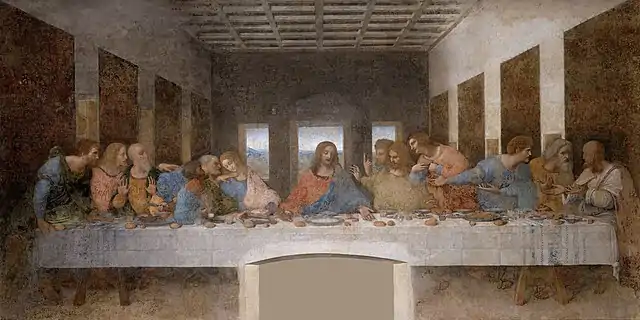 | |
| Artist | Leonardo da Vinci |
| Year | 1490s (Julian) |
| Movement | High Renaissance |
| Dimensions | 700 cm (280 in) × 880 cm (350 in) |
| Location | Convent of Santa Maria delle Grazie in Milan |
| Coordinates | 45°28′00″N 9°10′15″E |
| Website | cenacolovinciano |
The work is assumed to have been started around 1495–96 and was commissioned as part of a plan of renovations to the church and its convent buildings by Leonardo's patron Ludovico Sforza, Duke of Milan. The painting represents the scene of the Last Supper of Jesus with his apostles, as it is told in the Gospel of John, 13:21.[2] Leonardo has depicted the consternation that occurred among the Twelve Apostles when Jesus announced that one of them would betray him.
Due to the methods used, a variety of environmental factors, and intentional damage, little of the original painting remains today despite numerous restoration attempts, the last being completed in 1999.
Painting
Commission and creation
The Last Supper measures 460 cm × 880 cm (180 in × 350 in) and covers an end wall of the dining hall at the monastery of Santa Maria delle Grazie in Milan, Italy. The theme was a traditional one for refectories, although the room was not a refectory at the time that Leonardo painted it. The main church building was being completed (in 1498). Leonardo's patron, Ludovico Sforza, planned that the church should be remodeled as a family mausoleum, and to this end, changes were made, perhaps to plans by Bramante; these plans were not fully carried out, and a smaller mortuary chapel was constructed, adjacent to the cloister.[3] The painting was commissioned by Sforza to decorate the wall of the mausoleum. The lunettes above the main painting, formed by the triple arched ceiling of the refectory, are painted with Sforza coats-of-arms. The opposite wall of the refectory is covered by the Crucifixion fresco by Giovanni Donato da Montorfano, to which Leonardo added figures of the Sforza family in tempera; these figures have deteriorated in much the same way as has The Last Supper.[4]
Leonardo worked on The Last Supper from about 1495 to 1498, but did not work continuously. The beginning date is not certain, as the archives of the convent for the period have been destroyed. A document dated 1497 indicates that the painting was nearly completed at that date.[5] One story goes that a prior from the monastery complained to Leonardo about its delay, enraging him. He wrote to the head of the monastery, explaining he had been struggling to find the perfect villainous face for Judas, and that if he could not find a face corresponding with what he had in mind, he would use the features of the prior who had complained.[6][7]
In 1557, Gian Paolo Lomazzo wrote that Leonardo's friend Bernardo Zenale advised him to leave Christ's face unfinished, arguing that "it would be impossible to imagine faces lovelier or gentler than those of James the Greater or James the Less." Leonardo apparently took the advice.[8]
 The painting as it appears on the refectory wall
The painting as it appears on the refectory wall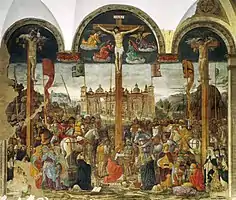 Crucifixion by Giovanni Donato da Montorfano, 1495, opposite Leonardo's Last Supper
Crucifixion by Giovanni Donato da Montorfano, 1495, opposite Leonardo's Last Supper
Medium
Leonardo, as a painter, favoured oil painting, a medium which allows the artist to work slowly and make changes with ease. Fresco painting does not facilitate either of these things. Leonardo also sought a greater luminosity and intensity of light and shade (chiaroscuro) than could be achieved with fresco.[9] Instead of painting with water-soluble paints onto wet plaster, laid freshly each day in sections, Leonardo painted The Last Supper on a wall sealed with a double layer of gesso, pitch, and mastic.[10] Then, borrowing from panel painting, he added an undercoat of white lead to enhance the brightness of the oil and tempera that was applied on top. This was a method that had been described previously by Cennino Cennini in the 14th century. However, Cennini described the technique as being more risky than fresco painting, and recommended the use of "a secco" painting (on dry plaster) for the final touches alone.[11]
Subject

The Last Supper portrays the reaction given by each apostle when Jesus said one of them would betray him. All twelve apostles have different reactions to the news, with various degrees of anger and shock. The apostles were identified by their names, using a manuscript[12][13] found in the 19th century. (Before this, only Judas, Peter, John and Jesus had been positively identified.) From left to right, according to the apostles' heads:
- Bartholomew, James, son of Alphaeus, and Andrew form a group of three; all are surprised.
- Judas Iscariot, Peter, and John form another group of three. Judas is wearing red, blue, and green and is in shadow, looking withdrawn and taken aback by the sudden revelation of his plan. He is clutching a small bag, perhaps signifying the silver given to him as payment to betray Jesus, or perhaps a reference to his role as a treasurer.[14] He is also tipping over the salt cellar, which may be related to the near-Eastern expression to "betray the salt" meaning to betray one's master. He is the only person to have his elbow on the table and his head is also vertically the lowest of anyone in the painting. Peter wears an expression of anger and appears to be holding a knife, foreshadowing his violent reaction in Gethsemane during the arrest of Jesus. Peter is leaning towards John and touching him on the shoulder, in reference to John's Gospel where he signals the "beloved disciple" to ask Jesus who is to betray him.[lower-alpha 1] The youngest apostle, John, appears to swoon and lean towards Peter.
- Jesus
- Thomas, James the Greater, and Philip are the next group of three. Thomas is clearly upset; the raised index finger foreshadows his incredulity of the Resurrection. James the Greater looks stunned, with his arms in the air. Meanwhile, Philip appears to be requesting some explanation.
- Matthew, Jude Thaddeus, and Simon the Zealot are the final group of three. Both Thaddeus and Matthew are turned toward Simon, perhaps to find out if he has any answer to their initial questions.
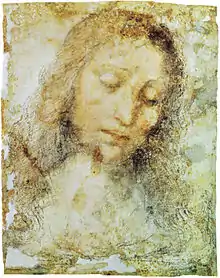
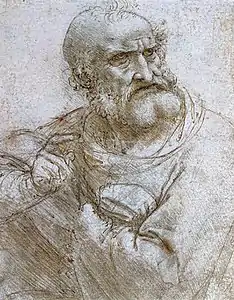
In common with other depictions of the Last Supper from this period, Leonardo seats the diners on one side of the table, so that none of them has his back to the viewer. Most previous depictions excluded Judas by placing him alone on the opposite side of the table from the other eleven disciples and Jesus, or placing halos around all the disciples except Judas. Leonardo instead has Judas lean back into shadow. Jesus is predicting that his betrayer will take the bread at the same time he does to Thomas and James the Greater to his left, who react in horror as Jesus points with his left hand to a piece of bread before them. Distracted by the conversation between John and Peter, Judas reaches for a different piece of bread not noticing Jesus too stretching out with his right hand towards it (Matthew 26: 23). The angles and lighting draw attention to Jesus, whose turned right cheek is located at the vanishing point for all perspective lines.[16] In addition, the painting demonstrated Da Vinci's masterful use of perspective as it "draws our attention to the face of Christ at the center of the composition, and Christ's face, through his down-turned gaze, directs our focus along the diagonal of his left arm to his hand and therefore, the bread." [17]
Leonardo reportedly used the likenesses of people in and around Milan as inspiration for the painting's figures. The convent's prior complained to Sforza of Leonardo's "laziness" as he wandered the streets to find a criminal to base Judas on. Leonardo responded that if he could find no one else, the prior would make a suitable model.[18] While the painting was being executed, Leonardo's friend, the mathematician Luca Pacioli, called it "a symbol of man's burning desire for salvation".[19]
History
Important copies
Two early copies of The Last Supper are known to exist, presumed to be work by Leonardo's assistants. The copies are almost the size of the original, and have survived with a wealth of original detail still intact.[20] One, by Giampietrino, is in the collection of the Royal Academy of Arts, London, and the other, by Cesare da Sesto, is installed at the Church of St. Ambrogio in Ponte Capriasca, Switzerland. A third copy (oil on canvas) is painted by Andrea Solari (c. 1520) and is on display in the Leonardo da Vinci Museum of the Tongerlo Abbey, Belgium.
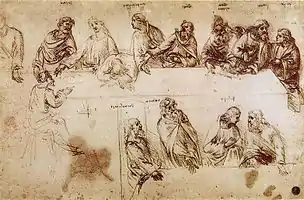 A study for The Last Supper[lower-alpha 2] from Leonardo's notebooks shows twelve apostles, nine of which are identified by names written above their heads. Judas sits on the opposite side of the table, as in earlier depictions of the scene.[15]
A study for The Last Supper[lower-alpha 2] from Leonardo's notebooks shows twelve apostles, nine of which are identified by names written above their heads. Judas sits on the opposite side of the table, as in earlier depictions of the scene.[15]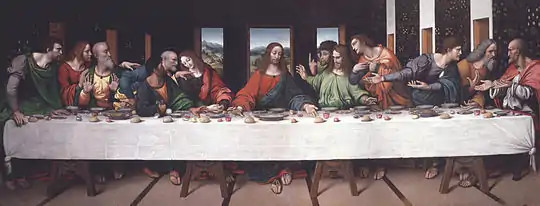 The Last Supper, c. 1520, by Giampietrino, oil on canvas, in the collection of the Royal Academy of Arts, London.[lower-alpha 3] This full-scale copy was the main source for the 1978–1998 restoration of the original. It includes several lost details such as Christ's feet and the salt cellar spilled by Judas. Giampietrino is thought to have worked closely with Leonardo when he was in Milan.
The Last Supper, c. 1520, by Giampietrino, oil on canvas, in the collection of the Royal Academy of Arts, London.[lower-alpha 3] This full-scale copy was the main source for the 1978–1998 restoration of the original. It includes several lost details such as Christ's feet and the salt cellar spilled by Judas. Giampietrino is thought to have worked closely with Leonardo when he was in Milan._-_WGA12732.jpg.webp) The Last Supper, c. 1520, Andrea Solari, oil on canvas, in the Leonardo da Vinci Museum, Tongerlo Abbey
The Last Supper, c. 1520, Andrea Solari, oil on canvas, in the Leonardo da Vinci Museum, Tongerlo Abbey
Damage and restorations

Because Sforza had ordered the church to be rebuilt hastily, the masons filled the walls with moisture-retaining rubble.[10] The painting was done on a thin exterior wall, so the effects of humidity were felt keenly, and the paint failed to properly adhere to it. Because of the method used, soon after the painting was completed on 9 February 1498 it began to deteriorate.[9] In 1499, Louis XII contemplated removing the painting from the wall and taking it to France.[23] As early as 1517, the painting was starting to flake, and in 1532 Gerolamo Cardano described it as "blurred and colorless compared with what I remember of it when I saw it as a boy".[24] By 1556 – fewer than sixty years after it was finished – Giorgio Vasari described the painting as reduced to a "muddle of blots" so deteriorated that the figures were unrecognizable.[10] By the second half of the 16th century, Gian Paolo Lomazzo stated that "the painting is all ruined".[9] In 1652, a doorway was cut through the (then unrecognisable) painting, and later bricked up; this can still be seen as the irregular arch-shaped structure near the center base of the painting. It is believed, through early copies, that Jesus' feet were in a position symbolizing the forthcoming crucifixion. In 1768, a curtain was hung over the painting for the purpose of protection; it instead trapped moisture on the surface, and whenever the curtain was pulled back, it scratched the flaking paint.
A first restoration was attempted in 1726 by Michelangelo Bellotti, who filled in missing sections with oil paint then varnished the whole mural. This repair did not last well and another restoration was attempted in 1770 by an otherwise unknown artist named Giuseppe Mazza. Mazza stripped off Bellotti's work then largely repainted the painting; he had redone all but three faces when he was halted due to public outrage. In 1796, French revolutionary anti-clerical troops used the refectory as an armory and stable;[25] they threw stones at the painting and climbed ladders to scratch out the Apostles' eyes. Goethe wrote that in 1800, the room was flooded with two feet of water after a heavy rainstorm.[10] The refectory was used as a prison; it is not known if any of the prisoners may have damaged the painting. In 1821, Stefano Barezzi, an expert in removing whole frescoes from their walls intact, was called in to remove the painting to a safer location; he badly damaged the center section before realizing that Leonardo's work was not a fresco. Barezzi then attempted to reattach damaged sections with glue. From 1901 to 1908, Luigi Cavenaghi first completed a careful study of the structure of the painting, then began cleaning it. In 1924, Oreste Silvestri did further cleaning, and stabilised some parts with stucco.
During World War II, on 15 August 1943, the refectory was struck by Allied bombing; protective sandbagging prevented the painting from being struck by bomb splinters,[26] but it may have been damaged by the vibration. Between 1946 and 1954, Mauro Pellicioli undertook a clean-and-stabilise restoration,[10] which Brera director Fernanda Wittgens was involved in.[25] Pellicioli reattached paint to the wall using a clear shellac, making it relatively darker and more colorful, and removed some of the overpainting.[27] However, as of 1972, the repainting done in various restorations had made the heads of saints Peter, Andrew, and James differ significantly from the original design.[10]
Major restoration
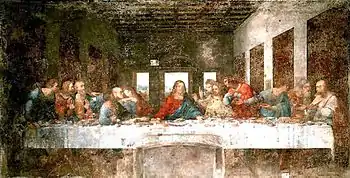
The painting's appearance by the late 1970s had become badly deteriorated. From 1978 to 1999, Pinin Brambilla Barcilon guided a major restoration project which undertook to stabilize the painting, and reverse the damage caused by dirt and pollution. The eighteenth- and nineteenth-century restoration attempts were also reversed. Since it had proved impractical to move the painting to a more controlled environment, the refectory was instead converted to a sealed, climate-controlled environment, which meant bricking up the windows. Then, detailed study was undertaken to determine the painting's original form, using scientific tests (especially infrared reflectoscopy and microscopic core-samples), and original cartoons preserved in the Royal Library at Windsor Castle. Some areas were deemed unrestorable. These were re-painted using watercolor in subdued colors intended to indicate they were not original work, while not being too distracting.[28]
This restoration took 21 years and, on 28 May 1999, the painting was returned to display. Intending visitors were required to book ahead and could only stay for 15 minutes. When it was unveiled, considerable controversy was aroused by the dramatic changes in colors, tones, and even some facial shapes. James Beck, professor of art history at Columbia University and founder of ArtWatch International, had been a particularly strong critic.[29] Michael Daley, director of ArtWatch UK, has also complained about the restored version of the painting. He has been critical of Christ's right arm in the image which has been altered from a draped sleeve to what Daley calls "muff-like drapery".[30]
In culture
The Last Supper has frequently been referenced, reproduced, or parodied in Western culture. Some of the more notable examples are:
Non-modern painting, mosaic, and photography
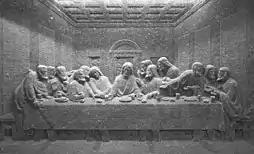

A 16th-century oil on canvas copy is conserved in the abbey of Tongerlo, Antwerp, Belgium. It reveals many details that are no longer visible on the original.[31] The Roman mosaic artist Giacomo Raffaelli made another life-sized copy (1809–1814), commissioned by Napoleon Bonaparte, that resides in the Minoritenkirche in Vienna.[32]
Modern art
In 1955, Salvador Dalí painted The Sacrament of the Last Supper, with Jesus portrayed as blond and clean shaven, pointing upward to a spectral torso while the apostles are gathered around the table heads bowed so that none may be identified. It is reputed to be one of the most popular paintings in the collection of the National Gallery of Art in Washington, D.C.
Mary Beth Edelson's Some Living American Women Artists / Last Supper (1972) appropriated The Last Supper, with the heads of notable women artists collaged over the heads of Christ and his apostles. The artists collaged over the heads of Christ and his apostles in Some Living American Women Artists / Last Supper include Lynda Benglis, Louise Bourgeois, Elaine de Kooning, Helen Frankenthaler, Nancy Graves, Lila Katzen, Lee Krasner, Georgia O'Keeffe, Louise Nevelson, Yoko Ono, M. C. Richards, Alma Thomas, and June Wayne.[33] As well, other women artists have their image shown in the border of the piece; in all eighty-two women artists are part of the whole image.[34][35] This image, addressing the role of religious and art historical iconography in the subordination of women, became "one of the most iconic images of the feminist art movement."[33][36]
Sculptor Marisol Escobar rendered The Last Supper as a life-sized, three-dimensional, sculptural assemblage using painted and drawn wood, plywood, brownstone, plaster, and aluminum. This work, Self-Portrait Looking at The Last Supper, (1982–84) is in New York's Metropolitan Museum of Art.[37]
In 1986, Andy Warhol was commissioned to produce a series of paintings based on The Last Supper that were exhibited initially in Milan. This was his last series of paintings before his death.[38]
Literature
Author Mary Shelley describes her impression of the painting in her travel narrative, Rambles in Germany and Italy, published 1844:
First we visited the fading inimitable fresco of Leonardo da Vinci. How vain are copies! not in one, nor in any print, did i ever see the slightest approach to the expression in our Savior's face, such as it is in the original. Majesty and love – these are the words that would describe it – joined to an absence of all guile that expresses the divine nature more visibly than I ever saw it in any other picture.[39]
— Mary Shelley, Travel Writing (1996), pp. 131–132
Film and television
In Luis Buñuel's 1961 Spanish film Viridiana, a tableau vivant of Leonardo's painting is staged with beggars. Another beggar "photographs" the scene by flashing them. This scene contributed to its refusal by the Vatican who called it "blasphemous." The painting is parodied in the original 1970 movie MASH, in the scene where Hawkeye Pierce stages a "last supper" for Walt (Painless) Waldowski before his planned suicide. The various doctors, all in surgical scrubs, pose in imitation of the painting. In Norman Jewison's 1973 film version of Jesus Christ Superstar, in the Last Supper sequence, Jesus and the 12 apostles briefly mimic the posture of each character in Da Vinci's painting. The painting is also parodied in Mel Brooks's 1981 movie History of the World, Part I, making Leonardo a contemporary of Jesus.
Many parodies of the painting appear on the small screen, including That '70s Show's 1998 first-season episode "Streaking," with Eric flanked by his friends (and Jackie wondering why everyone is sitting on the same side of the table); The Simpsons' 2005 Season 16 episode "Thank God, It's Doomsday", with Homer as Jesus and Moe and his other patrons as the disciples; and South Park's 2009 Season 13 episode "Margaritaville", with Kyle and his friends eating at a pizza parlor. In one 2015 episode of the CBC drama Murdoch Mysteries called Barenaked Ladies, the suspects recreate the poses of Peter, Judas, and Thomas in their victims.
Other speculation
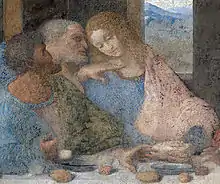
The Last Supper has been the target of much speculation by writers and historical revisionists alike, usually centered on purported hidden messages or hints found within the painting, especially since the publication of Dan Brown's novel The Da Vinci Code (2003), in which one of the characters suggests that the person to Jesus' right (left of Jesus from the viewer's perspective) is actually Mary Magdalene.[17][40] It also states that there was a letter ‘glaring in the center of the painting’ (M) standing for Matrimonio or Mary Magdalene. This speculation originated in earlier books The Templar Revelation (1997) by Lynn Picknett and The Holy Blood and the Holy Grail by Michael Baigent, Henry Lincoln and Richard Leigh (1982).[40] Art historians hold that the figure is the Apostle John,[17][40] who only appears feminine due to Leonardo's characteristic fascination with blurring the lines between the sexes, a quality which is found in his other paintings, such as St. John the Baptist (painted c. 1513–1516).[17][40] Christopher L. Hodapp and Alice Von Kannon comment, "If he [John] looks effeminate and needs a haircut, so does James, the second figure on the left."[40] According to Ross King, an expert on Italian art, Mary Magdalene's appearance at the last supper would not have been controversial and Leonardo would have had no motive to disguise her as one of the other disciples,[17] since she was widely venerated in her role as the "Apostle to the Apostles" and was the patron of the Dominican Order, for whom The Last Supper was painted.[17] There would have even been precedent for it, since the earlier Italian Renaissance painter Fra Angelico had included her in his painting of the Last Supper.[17]
The painting contains several possible numerical references, including to the number three. The Apostles are seated in groups of three, there are three windows behind Jesus, and the shape of Jesus' figure resembles a triangle. His hands are located at the golden ratio of half the height of the composition.[16] The painting can also be interpreted using the Fibonacci series: one table, one central figure, two side walls, three windows and figures grouped in threes, five groups of figures, eight panels on the walls and eight table legs, and thirteen individual figures.[16] Debates among art historians still surround the use of the Fibonacci series as some argue that its purposeful use did not fully begin to be applied to architecture until the early 19th century.[17]
Giovanni Maria Pala, an Italian musician, has indicated that the positions of hands and loaves of bread can be interpreted as notes on a musical staff and, if read from right to left, as was characteristic of Leonardo's writing, form a musical composition.[41][42][43]
References
Informational notes
- John 11:23-24
- The lower-right section continues the upper composition at left.[15]
- The painting hung in the chapel of Magdalen College, Oxford from 1992.[21]
Citations
- "Leonardo Da Vinci's 'The Last Supper' reveals more secrets". sciencedaily.com. Retrieved 3 March 2014.
- The Last Supper by Leonardo da Vinci –. "Santa Maria delle Grazie – Milan". Inexhibit. Retrieved 10 November 2017.
- "Santa Maria delle Grazie & The Last Supper". Timeout.com. Archived from the original on 29 March 2013. Retrieved 30 June 2019.
- King, Ross (2012). Leonardo and the Last Supper. New York: Bloomsbury. p. 271. ISBN 9781620403082.
- Kenneth Clark. Leonardo da Vinci, Penguin Books 1939, 1993, p. 144.
- "The Last Supper". lairweb.org.nz. Retrieved 21 December 2012.
- "DaVinci". The Mark Steel Lectures. Series 2. Episode 2. The Open University. 7 October 2003. BBC. Retrieved 21 December 2012.
- Durant, Will (2001). Heroes of History: A Brief History of Civilization from Ancient Times to the Dawn of the Modern Age. New York: Simon & Schuster. p. 206. ISBN 978-0-7432-2612-7. OCLC 869434122.
- "Leonardo's Last Supper". Smart history presented by the Khan Academy. Retrieved 25 February 2014.
- Wallace 1972, p. 83.
- "The Last Supper". The Last Supper. Retrieved 25 February 2014.
- "The Notebooks of Leonardo Da Vinci—Complete by Leonardo da Vinci". Gutenberg.org. 1 January 2004. Retrieved 14 February 2012.
- The Notebooks of Leonardo da Vinci p. 232)
- Cfr. Matthew 26:15 and John 12:6;13:29.
- Wallace 1972, p. 86.
- White, Susan D. (2006). Draw Like Da Vinci. London: Cassell Illustrated, p.132. ISBN 9781844034444.
- King, Ross (2012). Leonardo and the Last Supper. New York City, New York and London, England: Bloomsbury. pp. 187–189. ISBN 978-0-7475-9947-0.
- Wallace 1972, p. 81.
- Wallace 1972, p. 82.
- "Last Supper (copy after Leonardo)". University of the Arts, London. Retrieved 11 August 2008.
- "Chapel with return Renaissance painrefting". Oxford Times. 14 September 2017. p. 19.
- Wallace 1972, p. 74.
- Wallace 1972, p. 127.
- Wykes, Alan (1969). Doctor Cardano, physician extraordinary. p. 26.
- Da Vinci, Leonardo (1971). Taylor, Pamela (ed.). The Notebooks of Leonardo da Vinci. New American Library. p. xvii.
- Traverso, V. M. (5 June 2019). "How "The Last Supper" miraculously survived World War II bombs". Aleteia — Catholic Spirituality, Lifestyle, World News, and Culture. Retrieved 7 June 2019.
- Wallace 1972, p. 93.
- King, Ross (2012). Leonardo and the Last Supper. New York: Bloomsbury. ISBN 978-0802717054.
- Phillip William (24 May 1999). "The Last Supper or a dog's dinner?". The Guardian. guardian.co.uk. Retrieved 21 December 2012.
- Dayla Alberge (14 March 2012). "Have art restorers ruined Leonardo's masterpiece?". The Independent. Retrieved 21 December 2012.
- "Tongerlo Abbey Houses A Remarkable Treasure". Public Diplomacy Service of the Federal Public Service Foreign Affairs, Foreign Trade and Development Cooperation. Retrieved 20 March 2020.
- "Where you can see Napoleon's copy of Da Vinci's 'Last Supper'". TripAdvisor LLC. Retrieved 20 March 2020.
- "Mary Beth Edelson". The Frost Art Museum Drawing Project. Retrieved 11 January 2014.
- "Mary Beth Edelson. Some Living American Women Artists. 1972". MoMA. Retrieved 4 December 2019.
- Gail Levin (16 October 2018). Becoming Judy Chicago: A Biography of the Artist. Univ of California Press. pp. 209–. ISBN 978-0-520-30006-4.
- "Mary Beth Adelson". Clara - Database of Women Artists. Washington, D.C.: National Museum of Women in the Arts. Archived from the original on 10 January 2014. Retrieved 10 January 2014.
- "Self-Portrait Looking at The Last Supper". Metropolitan Museum of Art. Retrieved 15 August 2019.
- Haden-Guest, Anthony (3 August 1999). "Warhol's Last Supper". Artnet. Retrieved 12 March 2010.
- Shelley, Mary (1996). Travel Writing. London: Pickering. pp. 131–132. ISBN 1-85196-084-8.
- Christopher Hodapp, Alice Von Kannon, The Templar Code For Dummies, page 257 (Wiley Publishing, Inc., 2007. ISBN 978-0-470-12765-0).
- Rossella Lorenzi (9 November 2007). "Leonardo's 'Last Supper' Hides True Da Vinci Code". Discovery News. Retrieved 21 December 2012.
- "Da Vinci's "Last Supper" has hidden music (includes link to recording)". Extra.beloblog.com. Archived from the original on 23 July 2008. Retrieved 8 February 2009.
- mp3 file of the composition, hosted.ap.org
Bibliography
- Wallace, Robert (1972) [1966]. The World of Leonardo: 1452–1519. New York: Time-Life Books.
Further reading
- Steinberg, Leo. Leonardo's Incessant "Last Supper". New York: Zone Books, 2001.
- Detailed review of Steinberg's 'Incessant Last Supper' at 3 Pipe Problem
- Bertelli, Carlo (November 1983). "Restoration Reveals The Last Supper". National Geographic. Vol. 164 no. 5. pp. 664–684. ISSN 0027-9358. OCLC 643483454.
External links
| Wikimedia Commons has media related to Last Supper by Leonardo da Vinci. |
- Official website
- Leonardo's Last Supper and the three layers
- John the Apostle in Art
- Leonardo da Vinci: anatomical drawings from the Royal Library, Windsor Castle, exhibition catalog fully online as PDF from The Metropolitan Museum of Art, which contains material on The Last Supper (see index)
- Zoomable version
- Tourist Information
- "Leonardo's Last Supper" (video). Smarthistory at Khan Academy.
- Tickets